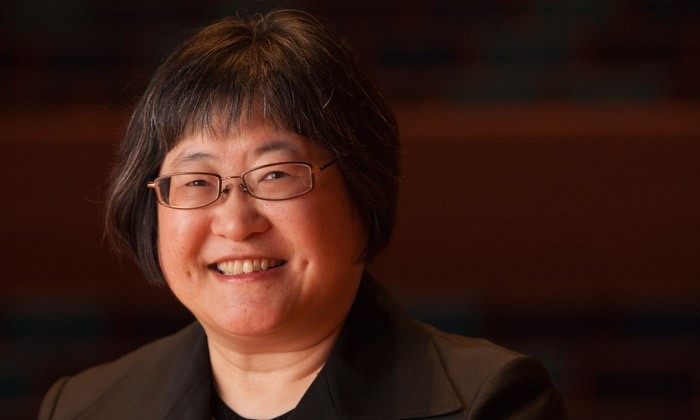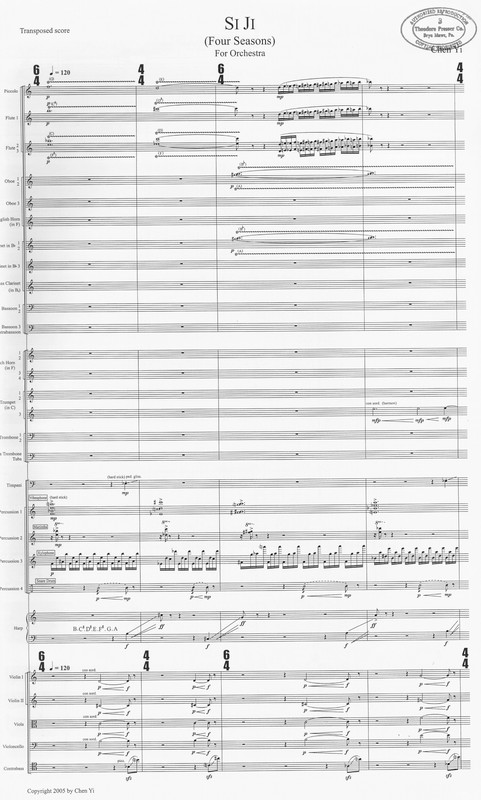-
Score title
-
Si Ji (Four Seasons)
-
Composer
-
Chen Yi
-
Program note
-
In the late summer of 2004, I was selected as the second Roche Commissions composer. In partnership with Lucerne Festival and Carnegie Hall, Roche asked me to write a new work for the Cleveland Orchestra to premiere on August 26, 2005, in Lucerne, on October 13 and 15 in Cleveland, and on October 17 in New York. The award ceremony was held at the Roche Forum Buonas, Switzerland. On another trip to Basel in the early summer, I had an exciting tour of Roche, one of the world's leading research-based healthcare companies, whose innovative work enhances well-being and quality of life of people worldwide. I visited Roche's R&D departments in pharmaceuticals and diagnostics, as well as the inspiring Tinguely Museum and the renowned Paul Sacher Foundation. I deeply appreciate Roche's achievement and admire its cultural tradition, which has played an important role in its development over the years. I think that traditions, inspiration and creation are closely related to one another, no matter whether in the arts or in science. From my East-West cultural background, my music is always a natural hybrid of Chinese traditional music elements and Western instrumentation and form, combined in my own musical language and style. In Chinese cultural tradition, in which I am deeply rooted, music is a part of an organic art form, along with poetry, calligraphy and painting. I love the traditional Chinese art, and think that it would be inspiring not only for artistic creation in an abstract form (as in my case, music composition), but also for scientific invention as an innovative process (as, perhaps, in the case of Roche research.)
In satisfying the Roche commission and seeking to contact with a wide range of listeners, I got the inspiration to compose my new orchestral work Si Ji (Four Seasons)from four ancient Chinese poems written by Su Shi (1036-1101) and Zeng Gong (1019-1083) in the Song Dynasty. The music is scored for 1 piccolo, 3 flutes, 3 oboes and 1 English horn, 3 clarinets and 1 bass clarinet, 3 bassoons and 1 contrabassoon, 4 horns, 3 trumpets, 3 trombones, 1 tuba, timpani, 4 percussionists, 1 harp and strings. The four Chinese ancient poems were written on beautiful yet dramatic scenes in the four seasons of nature. Musical textures permit me to present concretely the rich images and expressions that are given abstractly in the poems. The music, in a single movement with four sections corresponding to the four poems, should be performed without pause. It reflects the eternal evolution and challenges of nature and its analogous relationship to the challenges of the human experience. It has dramatic contrasts symbolizing the growth and maturation processes of individuals, communities and societies. It also suggests images of conflict, struggle, yearning, encouragement and triumph With my deep admiration and love, I have dedicated the work to Prof. Chou Wen-chung, to express my heartfelt gratitude to his mentorship in my creative life, and my respect to his great contribution to the culture of our new society.
Si Ji for orchestra starts with a quiet but vivid moving texture. The combination of the fast repeated figures played on the keyboard percussion instruments and the punctuations played on the harp and double basses (glissando and pizzicato) provides an ever-moving sounding background, to support the introduction of the simple but delicate pentatonic melodic material, which is played on the muted trumpets and joined by a group of French horns first, then a group of high woodwind instruments. According to the first poem that inspired me to catch my imagination for the music, the sonority is shimmering and the atmosphere is fresh and serene, as like a landscape in a watercolor painting. When the music moves forward with more and more instruments to join in, a dramatic change occurs with a huge burst from the orchestra. To make a big contrast in tone color, sound loudness and pitch range, here I have used, for the first time, all low brass, woodwind and percussion instruments to form a cluster in their lowest register with rhythmic arrangement, which supports the outbreak of the wide-range melody developed from the initial material, to reach the first tutti section in the piece. After the bold string unison line goes down to a virtuosic violin solo cadenza, the music turns into a mysterious mood. Am I inside of a deep ancient forest, being surrounded by thousands of mountains, or getting fascinated in an illusory dreamland? The high-low, far-near, dark-light, deep-shallow images are represented in multi-layers of sound blocks produced by various combinations of instruments. The music gradually builds up a momentum toward the last section, which opens up the whole spectrum of sound from the orchestra. The piece ends in a breathtaking climax, representing the strength and the perseverance of the human spirit.
 Chen Yi
Chen Yi

